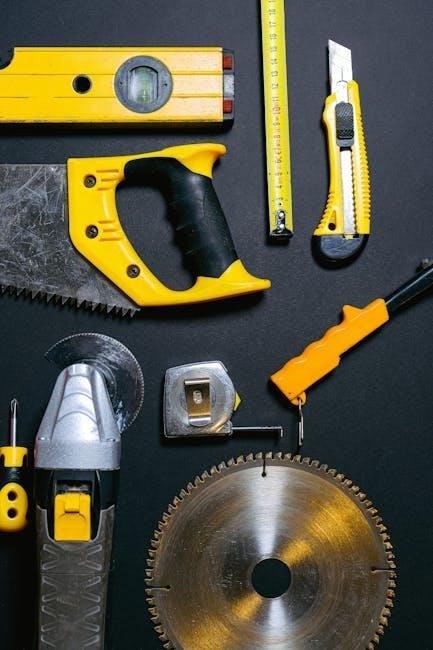Congratulations on purchasing the Rubbermaid 7×7 storage shed! This guide provides step-by-step instructions for successful assembly, ensuring durability and functionality. Follow these instructions carefully to achieve a proper setup.
Assembly requires careful preparation and attention to detail. This guide will help you navigate the process smoothly, from unpacking components to final touches. Happy building!
Overview of the Rubbermaid 7×7 Storage Shed
The Rubbermaid 7×7 storage shed is a durable and versatile solution for outdoor storage needs. Designed with double-walled construction, it offers strength and weather resistance. Its compact 7×7 feet size makes it ideal for small spaces. The shed features a sloped roof to prevent water pooling and includes vents for airflow. Assembly requires basic tools and careful preparation. Lubricate roof snaps and ensure a level surface before starting. Follow the instructions step-by-step to secure panels and hardware properly. This shed is perfect for storing gardening tools, equipment, and outdoor items, ensuring your space remains organized and clutter-free.
Importance of Following Assembly Instructions
Following the assembly instructions for your Rubbermaid 7×7 storage shed ensures a safe, durable, and functional structure. Proper assembly prevents potential damage and extends the shed’s lifespan. Misaligned panels or loose hardware can lead to structural weaknesses and safety hazards. By adhering to the guidelines, you maintain the product’s warranty and achieve optimal performance. Take time to review each step, lubricate roof snaps, and secure components as directed. This attention to detail guarantees a sturdy and weather-tight shed, protecting your belongings for years to come.

Preparation for Assembly
Ensure a solid, level surface and verify local building regulations. Unpack and organize all components, lubricate roof snaps, and prepare tools for a smooth assembly process.
Checking Local Building Regulations
Before assembling your Rubbermaid 7×7 storage shed, ensure compliance with local building codes and regulations. Verify if permits are required for outdoor structures. Check setbacks from property lines, fencing, and neighboring buildings. Ensure the shed’s placement adheres to local zoning laws. Some areas may restrict shed size, height, or materials. Additionally, confirm if there are specific requirements for foundation depth or type. It’s essential to comply with these regulations to avoid potential fines or removal of the structure. Consulting with local building authorities beforehand can prevent future complications. This step ensures your shed is legally and safely installed.
Preparing the Site for Shed Installation
Ensure the installation site is clear of debris, vegetation, and obstructions. Choose a flat, dry area to prevent water accumulation and structural issues. Mark the shed’s footprint using the provided dimensions. Check for underground utilities to avoid accidental damage. If necessary, level the ground using sand or gravel for stability. Proper drainage is crucial; consider sloping the site slightly to direct water away. Ensure the area is accessible for assembly. If building on uneven terrain, create a level surface using appropriate materials. A well-prepared site ensures a smooth assembly process and extends the shed’s longevity. Always follow local guidelines for outdoor structures.
Unpacking and Organizing Components
Carefully unpack all components from the boxes and verify each item against the inventory list provided. Organize parts by category, such as walls, roof panels, hardware, and tools. Label each group for easy identification during assembly. Check for any damaged or missing items and contact customer support immediately if issues arise. Lubricate roof snaps on the front and back gables to ensure smooth installation. Place smaller hardware, like screws and bolts, in sealed containers to prevent loss. Having all components ready and accessible will streamline the assembly process. Proper organization is key to avoiding delays and ensuring a successful build.

Safety Precautions
Always wear protective gear, including gloves and safety glasses, during assembly. Ensure the work area is clear and well-lit to prevent accidents. Follow all safety guidelines carefully.
General Safety Guidelines for Assembly
Always prioritize safety during assembly to avoid injuries and ensure a smooth process. Wear protective gear, including gloves and safety glasses, to protect yourself from sharp edges and debris.
Ensure the workspace is clear of obstacles and well-lit to maintain visibility and prevent tripping hazards. Use tools correctly and avoid overreaching or stretching, which could lead to accidents.
Follow the instruction manual carefully and avoid improvising steps, as this could compromise the shed’s stability. If unsure about any part, consult the manufacturer’s guidelines or seek professional assistance.
Protective Gear Recommendations
Safety is crucial during assembly. Wear sturdy gloves to protect your hands from cuts and abrasions when handling sharp edges or heavy components.
Use safety glasses to shield your eyes from debris or small parts that may become dislodged during the process. A dust mask is also recommended when drilling or sawing materials.
Ensure proper footwear with slip-resistant soles to maintain stability and prevent accidents. Avoid loose clothing that could get caught in tools or components. Prioritize your well-being throughout the assembly process.

Understanding the Components
Familiarize yourself with the shed’s components, including panels, frame, and roof sections. Organize all parts before starting to ensure efficient assembly and minimize delays.
Identifying Key Parts of the Shed
Begin by identifying the shed’s main components, such as the roof panels, wall sections, door frames, and floor kit. Each part is labeled for easy recognition. The roof panels feature arrows indicating proper orientation, while wall sections include pre-drilled holes for assembly. The door frame and hardware are packed separately for easy access. Ensure all components are accounted for before starting. Proper identification ensures a smooth assembly process and prevents delays. Take time to organize and label each part according to the instructions for efficiency. This step is critical for a successful and stress-free assembly experience.
Hardware and Tools Required
To successfully assemble the Rubbermaid 7×7 shed, gather the necessary hardware and tools. Included in the package are bolts, screws, and clips specific to the shed’s design. You will need a screwdriver, wrench, and rubber mallet for assembly. A measuring tape and level ensure accurate alignment. Safety glasses and gloves are recommended for protection. A ladder may be required for roof installation. Lubricate roof snaps as indicated in the instructions. Ensure all hardware is organized to avoid misplacement. Optional tools like a cordless drill can speed up the process. Proper tools and hardware are essential for a secure and efficient assembly experience.

Foundation and Base Preparation
A level surface is essential for the shed’s stability. Ensure the foundation meets minimum dimensions and complies with local building regulations for a secure setup.
Building a Level Surface for the Shed
A level surface is crucial for the stability and proper functioning of your Rubbermaid 7×7 shed. Begin by clearing the area of debris and vegetation. Mark the shed’s footprint using stakes and string to define the space. Check the ground for levelness using a spirit level or similar tool. If the ground is uneven, excavate high spots or fill low areas with compacted gravel or sand. Ensure the surface is firm and even before proceeding. This step ensures the shed’s foundation is secure and prevents future structural issues. Always refer to the instruction manual for specific recommendations on surface preparation.
Optional Foundation Types for the Shed

While a level surface is sufficient for your Rubbermaid 7×7 shed, optional foundation types can enhance stability and durability. A gravel base is a popular choice, providing excellent drainage and a sturdy platform. Alternatively, a concrete slab offers long-lasting support and is ideal for heavy use. Another option is a wooden platform, such as pressure-treated lumber, which elevates the shed and protects it from moisture. Each foundation type has its benefits, and the choice depends on personal preference, soil conditions, and intended use. Always ensure the foundation aligns with local building codes and the shed’s specifications for optimal performance.

Assembling the Shed Walls
Construct the frame using the provided hardware and align the wall panels carefully. Secure each panel to the frame, ensuring proper fit and alignment. Follow instructions precisely.
Constructing the Frame and Panels
Begin by assembling the frame according to the instructions, ensuring all pieces align properly. Use the provided hardware to secure the frame sections together tightly. Once the frame is complete, attach the wall panels one by one, starting from the bottom and working upwards. Align each panel with the frame edges and use the recommended fasteners to secure them firmly. Make sure the panels are evenly spaced and properly seated to maintain structural integrity. Double-check that all connections are tight and the frame is square before moving on to the next step. This ensures a sturdy base for the shed walls.
Securing the Walls Together
Start by aligning the back wall with the floor frame, ensuring it fits snugly. Use the provided screws to secure it tightly. Repeat this process for the remaining walls, making sure each one is properly aligned with the frame and adjacent panels. Use the alignment tabs and slots to guide the panels into place. Once all walls are in position, use the recommended fasteners to secure them together, starting from the bottom and working upwards. Ensure all connections are tight and the structure feels sturdy. Double-check that the walls are square and evenly spaced before proceeding to the roof installation.

Installing the Roof
Prepare the roof panels by lubricating the snaps. Align the left roof panel with the shed’s front edge, ensuring arrows point forward. Secure firmly with provided fasteners.
Preparing the Roof Panels
Begin by lubricating the roof snaps on the front and rear gables to ensure smooth assembly. Locate the left and right roof panels, each marked with directional arrows. Align the left roof panel with the front edge of the shed, ensuring the arrows point forward. Gently place the panel onto the shed’s frame, securing it with the provided hardware. Repeat this process for the right roof panel, making sure it fits snugly alongside the left one. Tighten all connections firmly to prevent gaps or movement. For added stability, consult the instruction manual for specific alignment guides. Double-check the panels’ alignment before proceeding to the final attachment step.
Attaching the Roof to the Shed Structure
Once the roof panels are prepared, carefully lift them onto the shed structure. Align the panels with the pre-marked positions on the shed frame, ensuring proper fitment. Secure the panels using the provided hardware, tightening bolts firmly to prevent movement. Check that all snaps and connections are tightly fastened to maintain structural integrity. Verify that the roof is evenly aligned and properly seated on the walls. For added stability, ensure all screws are tightened evenly. After securing, inspect the roof for any gaps or misalignments and address them immediately. This step is crucial for ensuring the shed is weather-tight and secure. Follow the manufacturer’s guidelines for final tightening.

Final Assembly and Touch-ups
Ensure all parts are securely fastened and double-check for any gaps or misalignments. Make final adjustments to ensure the shed is square and sturdy. Tighten any loose screws or hardware for a polished finish.
Ensuring All Parts Are Securely Fastened
Once all components are assembled, inspect every bolt, screw, and clip to ensure they are tightly secured. Verify that all panels are properly aligned and snugly fitted. Pay special attention to the roof snaps and gable connections, as these are critical for structural integrity. Use a wrench to tighten any loose hardware, and ensure no gaps remain between panels. Double-check the door hinges and locking mechanism for smooth operation. Properly securing all parts guarantees the shed’s stability and durability, especially against weather conditions. Take your time to methodically review each connection for a secure and professional finish.
Final Inspection and Adjustments
After completing the assembly, conduct a thorough inspection to ensure everything is perfectly aligned and functioning as intended. Check for any loose hardware and tighten if necessary. Verify that all panels, doors, and locks operate smoothly and securely. Inspect the roof for proper alignment and ensure all snaps are securely fastened. Make any necessary adjustments to the doors or hinges for proper closure. Finally, walk around the shed to confirm that it is level, stable, and free from any gaps or misalignments. This final check ensures your Rubbermaid shed is ready for use and will perform optimally in various weather conditions.

Tips for a Successful Assembly
Plan ahead, gather all tools, and lubricate roof snaps. Follow instructions carefully, assemble panels accurately, and ensure a level surface. Work methodically for a sturdy shed.
Recommendations for a Single-Person Assembly
Assembling the Rubbermaid 7×7 shed alone is achievable with careful planning. Start by organizing all components and tools beforehand. Lubricate roof snaps to ease panel alignment. Use clamps or stands to hold pieces steady while securing them. Work methodically, following instructions step-by-step, and avoid rushing. Take regular breaks to maintain focus and prevent fatigue. Ensure the foundation is perfectly level before proceeding with wall assembly. If needed, use a second pair of hands for heavier sections like roof panels. Patience and attention to detail are key to a successful solo assembly. Proper preparation and pacing will result in a sturdy, well-constructed shed.
Common Mistakes to Avoid
When assembling the Rubbermaid 7×7 shed, common mistakes include not checking local building regulations beforehand and improperly preparing the site. Ensure the foundation is level and sturdy to avoid structural issues. Mismanaging hardware or skipping steps in the instructions can lead to misalignment or instability. Avoid rushing the process, as this may result in poorly secured panels or incorrect assembly. Additionally, ignoring safety guidelines, such as not wearing protective gear, can lead to accidents. Double-check all connections and bolts before moving to the next step. Proper sequencing and attention to detail are crucial for a successful and durable assembly.
